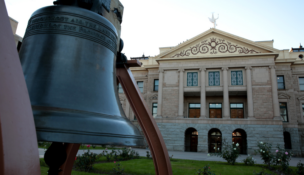States take sides on stem cell research
Arizona Capitol Reports Staff//February 8, 2008//[read_meter]
States take sides on stem cell research
Arizona Capitol Reports Staff//February 8, 2008//[read_meter]
In the 10 years since University of Wisconsin scientists announced they had harvested potentially life-saving stem cells from human embryos, the bioethical dilemma presented by the science has stymied the federal government, split the GOP and has been debated in nearly every statehouse in the country.
Now, as the pace of new scientific discoveries in the field quickens, seven states — California, Connecticut, Illinois, Maryland, New Jersey, New York and Wisconsin — are leading the world in financial and political support for stem-cell research, and Massachusetts is poised to join them.
Three — Iowa, Massachusetts and Missouri — have made the research legal, but not offered state funding, while six — Arkansas, Indiana, Louisiana, Michigan, North Dakota and South Dakota — have taken the path of most developed countries and restricted the studies.
President Bush and other opponents argue that stem-cell research that results in the destruction of human embryos is immoral. Scientists, patients and their advocates seek the freedom and resources to conduct this embryonic research they say could cure diseases that affect millions of Americans.
With powerful forces on both sides, Washington has remained stalled.
“The lack of federal leadership leaves a vacuum that states are trying to fill on a very piecemeal basis,” said Michigan state Rep. Andy Meisner, a Democrat, who has to tried to repeal his state’s ban on the research for the past four years.
Bush said in his State of the Union Address on Jan. 28 that groundbreaking new stem-cell research in which ordinary skin cells could replace the use of human embryos “has the potential to move us beyond the divisive debates of the past.”
But far from resolving the moral quandary, last November’s highly publicized breakthrough has escalated the discussion.
Scientists around the world quickly cautioned that years of work remained to perfect the promising new technique, and continuing parallel work on embryonic stem cells is an essential part of that process. While they unanimously agreed the new skin-cell work is groundbreaking, scientists said many questions remain, including whether the method can be safely used for human therapies.
Even if federal funding for the new skin-cell studies is expanded, as Bush suggested in his address, scientists say they also would need money to continue embryonic studies.
Since August 2001, when Bush allowed limited federal funding of the embryonic stem-cell research, Congress has been unable to open up more federal dollars, despite pressure from the scientific community and support from a majority of Americans. Congressional attempts to ban the science also have been unsuccessful, making the research legal unless prohibited by state law.
In January 2004, New Jersey was the first to underwrite embryonic stem-cell research, appropriating $10 million and taking on a role historically held by the federal government’s esteemed National Institutes of Health (NIH). California came next with its November 2004 voter-approved fund of $3 billion and immediately outstripped all other investors.
Other states followed. In the last two years, states have distributed some $230 million in grants — more than three times as much as the federal government spent on embryonic stem-cell science in the same period — and there has been no shortage of scientists seeking the funding. Over the next decade, states are committed to spending nearly $5 billion on the science and Massachusetts may add another billion.
Since 2001, nearly every state has bitterly debated the question of whether the work should be banned for moral reasons or supported for its potential to cure many of the world’s chronic and debilitating diseases.
Also at stake in deciding whether to support the research is the nation’s longstanding leadership role in medical science and states’ eagerness to claim a piece of an exploding new field that could bring high-paying jobs and big investments in universities and businesses.
“State policies will determine which states will become magnets for high-tech research and which will become irradiated zones for the same kind of research,” said Daniel Perry of the Alliance for Aging Research, a citizen advocacy group for stem cell research.
National polls indicate a majority of Americans approve of the research, which uses cells found in four-day old human embryos that can transform into cells that form tissue from any organ of the body. Scientists say these so-called pluripotent stem cells hold the key to discovering the causes and cures for conditions such as juvenile diabetes, blindness, spinal paralysis, Lou Gherig’s, Alzheimer’s and Parkinson’s disease.
Both sides in the stem cell debate were jubilant over a pre-Thanksgiving Day 2007 announcement from research teams in Japan and the University of Wisconsin that human skin cells had been coaxed into becoming cells that appeared to have the same pluripotent qualities previously considered unique to cells derived from human embryos.
Bush and other anti-abortion opponents saw the new work as a victory in their fight against embryonic stem-cell research.
“This advance reminds us once again that medical progress and respect for human life are not in conflict; they can and should support and enrich one another for the good of all,” said Cardinal Justin Rigali of the U.S. Conference of Catholic Bishops.
The skin-cell breakthrough came after almost all states had ended their 2007 legislative sessions, so its impact will be measured in 2008.
Opponents of embryonic studies may rally for more state bans on the work, but they also could call for new investment in non-controversial techniques. Proponents may push for more state funding of comparative embryonic research to speed testing and development of the new technique.
Massachusetts lawmakers this year will weigh Democratic Gov. Deval Patrick’s proposal to join the pack of states funding stem-cell and other biomedical studies by investing $1 billion.
If the next president decides to drop Bush’s restrictions on stem-cell funding, Congress could press again for federal money. The current policy put in place by Bush allows federal funding only for work on embryonic stem-cell lines created before Aug. 9, 2001, preventing any further destruction of embryos using federal money.
In 2006 and 2007, Bush vetoed bipartisan bills that would have allowed federal funding for the creation of new stem-cell lines using surplus embryos and research on existing cell lines created since Bush’s cutoff date. Neither bill included appropriations.
Even if the next Congress and president are willing, the extent of any federal funding is another question.
“With a budget deficit and the war in Iraq, the odds of a major bump in federal stem-cell funding are slim no matter who is elected president,” said James Fossett, a bioethicist with the Rockefeller Institute of Government. “The economic opportunities presented by the research make it unlikely states will diminish their funding efforts.”
States in flux
While some states have taken definitive action for or against the science, the issue is unsettled in much of the country.
“Politicians don’t want to enter the quagmire of ethics and science if they don’t have to,” said Patrick Kelly, state strategist at the Biotechnology Industry Association. “There is no real middle ground — no compromise to be had,” he said.
Even in states with laws supporting embryonic research, turmoil persists.
After California voters approved the state’s landmark funding initiative in 2004, opponents tied up the money in court battles over copyright and other issues for more than two years.
In Missouri, even a 2006 voter-approved constitutional amendment legaliz
ing the research did not settle the issue. In 2007, lawmakers tried to pass a new ballot measure overturning the amendment and rejected Republican Gov. Matt Blunt’s funding request for bioscience research facilities at the University of Missouri, because they said the buildings might house the controversial studies.
As a result of these skirmishes, Missouri’s biggest research organization — the nonprofit Stowers Institute for Medical Research — put local projects on ice and invested instead in research at Harvard University in Massachusetts.
In 2006, shortly after Connecticut began distributing its first grants for stem-cell research, conservative lawmakers unsuccessfully attempted to outlaw the studies and repeated their efforts again in 2007.
On Election Day 2007 in New Jersey, voters defeated Democratic Gov. Jon Corzine’s bid to raise an additional $450 million for new stem-cell grants. Although some voters objected to the proposal on moral grounds, political analysts said most were worried about how the cash-strapped state would repay the loans.
In the past year, 39 states considered more than 100 bills for and against the research, but only three laws were enacted: New York’s new funding bill, Iowa’s repeal of a five-year-old research ban, and Illinois’ law supporting Democratic Gov. Rod Blagojevich’s 2005 executive order creating a research fund, according to the National Conference of State Legislatures.
In the newly announced research involving skin cells, scientists created what they say appear to be pluripotent cells by coaxing or “reprogramming” adult skin cells to revert to an embryonic stem-cell-like state referred to as induced pluripotent cells.
Cloning, or SCNT, used in many embryonic stem-cell studies, ultimately may be replaced with the newly developed induced pluripotent cells. SCNT — perfected by the Scottish scientist Ian Wilmut, who produced Dolly the cloned sheep in 1996 — replaces the DNA in an egg with DNA from another organism.
The new skin-cell technique produces stem cells with the same DNA as the donor, and scientists believe it ultimately will make SCNT unnecessary. In addition to avoiding the ethical controversy over creating and destroying embryos, scientists point out that the new technique avoids the cumbersome process of acquiring donated eggs and embryos.
In 1998, a team lead by James Thompson at the University of Wisconsin was the first to successfully harvest pluripotent stem cells from embryos donated by fertilization clinics. Since then, scientists have developed some 400 embryonic stem-cell lines using private and public research funds. Thompson’s lab – which also developed the most recent discovery involving skin cells —houses the majority of federally-approved stem-cell lines and his skin-cell research — considered non-controversial from the outset —was funded in part by NIH.
Bioscience bonanza
Scientists predict embryonic stem-cell research will lead to therapies in 15 to 20 years, making states’ investments in the science a long-range proposition. But when and if therapies are developed, experts predict a multi-billion dollar boom in the pharmaceutical and bioscience industries, plus billions more in health care savings.
California voters agreed to borrow $3 billion for the research based in part on an economic study projecting savings of up to $6.9 billion in state health-care costs, $1.1 billion in royalties and some 20,000 new high-paying jobs over the next 30 years.
In the short term, states are competing to attract the best and brightest scientists to lead the research.
“California changed everything,” said Bernard Siegel founder of the Genetics Policy Institute, a non-profit stem cell advocacy group. “No state wanted to see their best scientists pick up and move to California,” he said.
As Gov. Arnold Schwarzenegger, a Republican, predicted when California voters approved their landmark 2004 ballot measure authorizing the stem-cell investment, the message has gone out to “the world’s scientific elite and aspiring students that, in California, you will find the resources and the freedom to expand the frontiers of science.”
Now that grant money is flowing, the California Institute of Regenerative Medicine (CIRM) reports it has wooed more than two-dozen of the world’s top stem-cell scientists, including Japanese scientist Shinya Yamanaka, who lead the most recent skin-cell discoveries at the University of Kyoto. Yamanaka accepted a state grant in August 2007 and began working part-time in San Francisco to avoid stem-cell restrictions in Japan.
Since 2003, NIH has given $159 million to embryonic stem-cell researchers and expects to spend $37 million in 2008. NIH also has a 2008 budget of $240 million for adult stem-cell studies, which could be used to fund the newly discovered stem-cell techniques involving skin cells.
States that restrict or ban stem-cell research
Laws in 31 states regulate research on human embryos and fetal tissue, but only Louisiana (2000) and Michigan (1978) ban the use of human embryos in stem-cell studies. Louisiana prohibits research on surplus embryos from in vitro fertilization clinics and Michigan outlaws research on embryos from any source, according to the National Conference of State Legislatures (NCSL).
In addition, 15 states have banned so-called reproductive cloning aimed at creating a duplicate human. Of the 15, only five extend the ban to the type of cloning used in stem-cell research: Arkansas (2003), Indiana (2003), Michigan (1998), North Dakota (2003) and South Dakota (2004), according to NCSL.
Arizona prohibits the use of state funds for embryonic stem-cell research and Nebraska forbids use of tobacco settlement funds, according to NCSL.
Even in states that generally support embryonic stem-cell studies, new laws restrict the research.
Illinois and Massachusetts prohibit the creation of an embryo in a laboratory, by combining a human egg and a human sperm, for the sole purpose of research. In both states, scientists can work on such embryos, but only if they are created by scientists outside of the state. The Massachusetts health department in 2007 rewrote regulations that previously prohibited scientists in the state from working with so-called in vitro embryos created in out-of-state labs.
Also restricting the research are laws in California and Massachusetts that ban scientists from paying women for their unfertilized eggs. In both states, scientists say the laws make it difficult to get enough human eggs for research. Maryland prohibits the use of donated human eggs for research funded by the state.
States that fund stem-cell studies
New Jersey became the first state, in 2004, to support stem-cell research, earmarking $10 million to be distributed over 10 years to university, non-profit and commercial labs in the state. Since then, lawmakers have appropriated another $15 million for grants and $9.5 million to cover administrative costs of the program. So far, the state has distributed $7.6 million, $899,000 of which has gone to embryonic studies. In 2007, Democratic Gov. Jon Corzine signed legislation for another $270 million to build and equip five stem-cell and biomedical research facilities. In the 2007 elections, New Jersey voters said “no” to Corzine’s proposed $450 million bond measure for continued funding, a proposal opposed by anti-abortion group New Jersey Right to Life.
California voters on Nov. 2, 2004, approved Proposition 71, a 10-year, $3 billion funding program. The program became embroiled in legal proceedings over patent rights to the resulting discoveries and the makeup of the grant program’s governing board. Because funding was stalled, Gov. Schwarzenegger gave the program a state loan of $150 million in August 2006. In June 2007, the California Institute of Re
generative Medicine approved grants of $50 million for stem cell research at 17 academic and nonprofit institutions.
Connecticut Gov. M. Jodi Rell, a Republican, signed a measure in June 2005 to provide $100 million in state funding over 10 years for embryonic stem-cell research. The first round of grants — nearly $20 million — was awarded in November 2006 by the Connecticut Stem Cell Research Advisory Committee to support researchers at three universities in the state.
Illinois Gov. Rod Blagojevich, a Democrat, directed the public health department in July 2005 to grant $10 million to stem-cell projects over 10 years and added $5 million more to the fund in July 2006, after Bush vetoed a bill seeking to open up federal funding for the science. In August 2006, the Illinois Regenerative Medicine Institute granted $5 million to seven projects at Illinois public universities. In 2007, the Illinois legislature codified the governor's allocations.
Maryland Gov. Robert Ehrlich,a Republican, who later lost his re-election bid, signed a measure in 2006 appropriating $15 million in general funds to be distributed in 2007. First-term Gov. Martin O’Malley, a Democrat, appropriated an additional $23 million to be distributed in 2008. On May 17, 2007, the Maryland Stem Cell Commission gave its first grants to 24 research teams at the University of Maryland and Johns Hopkins University. On Oct. 1, 2007, the Maryland Technology Development Fund asked for proposals for a second round of grants.
Wisconsin Gov. Jim Doyle, a Democrat, a vocal supporter of federal funding for stem-cell research, created a $750 million investment fund, including public and private money, to build a research facility where embryonic stem-cell studies may be conducted. The Wisconsin Institutes for Discovery, already under construction, will be located on the campus of the University of Wisconsin-Madison, where scientists first harvested embryonic stem cells.
New York Gov. Eliot Spitzer, a Democrat, signed a budget measure in April 2007 that sets aside $600 million for stem-cell research over the next 11 years. Spitzer’s deputy, Lt. Gov. David Paterson, assembled a board to run the Empire State Stem Cell Trust, which on Jan. 7, 2008, distributed $14.5 million in grants to 25 universities and non-profit organizations in the state.
Massachusetts Gov. Deval Patrick, a Democrat, in May 2007 proposed $1 billion in funding for stem-cell research, a move aimed at sealing the state's reputation as a worldwide leader in biotechnology. The legislature is considering the proposal this year. Also in 2007, the public health department lifted a barrier to the research created by previous governor and presidential hopeful, Republican Mitt Romney, an opponent of stem-cell research. A statute enacted in 2005 ensures the legality of embryonic stem-cell research.
Iowa Gov. Chet Culver signed a bill in 2007 repealing a 2002 state ban on the cloning techniques used in the research and ensured the legality of all forms of stem-cell research. The first-term Democrat asked for $12.5 million to help build a stem-cell research center at the University of Iowa, but his proposal was turned down by the legislature.
Missouri voters in 2006 narrowly approved a ballot initiative establishing in the state constitution scientists’ rights to conduct the research and patients’ rights to receive the therapies. The Missouri initiative came in reaction to legislative attempts to ban the research, moves that were repeated in 2007 as conservative lawmakers tried to repeal the amendment by putting the issue on the ballot in 2008.
Contact Christine Vestal at cvestal@stateline.org? Stateline.org is an independent element of the Pew Research Center and is based in Washington, DC
















